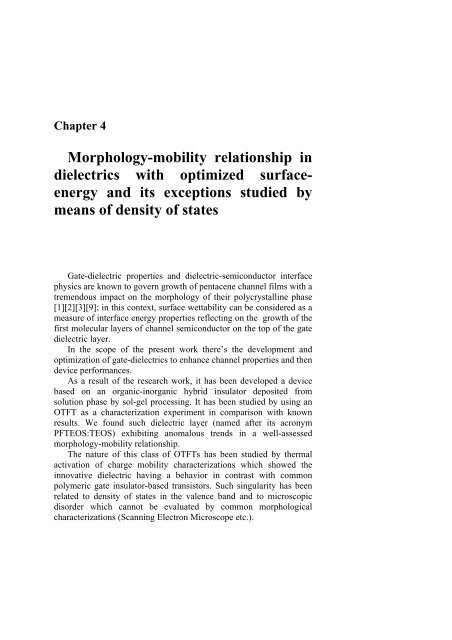tesi R. Miscioscia.pdf - EleA@UniSA
tesi R. Miscioscia.pdf - EleA@UniSA
tesi R. Miscioscia.pdf - EleA@UniSA
You also want an ePaper? Increase the reach of your titles
YUMPU automatically turns print PDFs into web optimized ePapers that Google loves.
Chapter 4<br />
Morphology-mobility relationship in<br />
dielectrics with optimized surfaceenergy<br />
and its exceptions studied by<br />
means of density of states<br />
Gate-dielectric properties and dielectric-semiconductor interface<br />
physics are known to govern growth of pentacene channel films with a<br />
tremendous impact on the morphology of their polycrystalline phase<br />
[1][2][3][9]; in this context, surface wettability can be considered as a<br />
measure of interface energy properties reflecting on the growth of the<br />
first molecular layers of channel semiconductor on the top of the gate<br />
dielectric layer.<br />
In the scope of the present work there’s the development and<br />
optimization of gate-dielectrics to enhance channel properties and then<br />
device performances.<br />
As a result of the research work, it has been developed a device<br />
based on an organic-inorganic hybrid insulator deposited from<br />
solution phase by sol-gel processing. It has been studied by using an<br />
OTFT as a characterization experiment in comparison with known<br />
results. We found such dielectric layer (named after its acronym<br />
PFTEOS:TEOS) exhibiting anomalous trends in a well-assessed<br />
morphology-mobility relationship.<br />
The nature of this class of OTFTs has been studied by thermal<br />
activation of charge mobility characterizations which showed the<br />
innovative dielectric having a behavior in contrast with common<br />
polymeric gate insulator-based transistors. Such singularity has been<br />
related to density of states in the valence band and to microscopic<br />
disorder which cannot be evaluated by common morphological<br />
characterizations (Scanning Electron Microscope etc.).
















